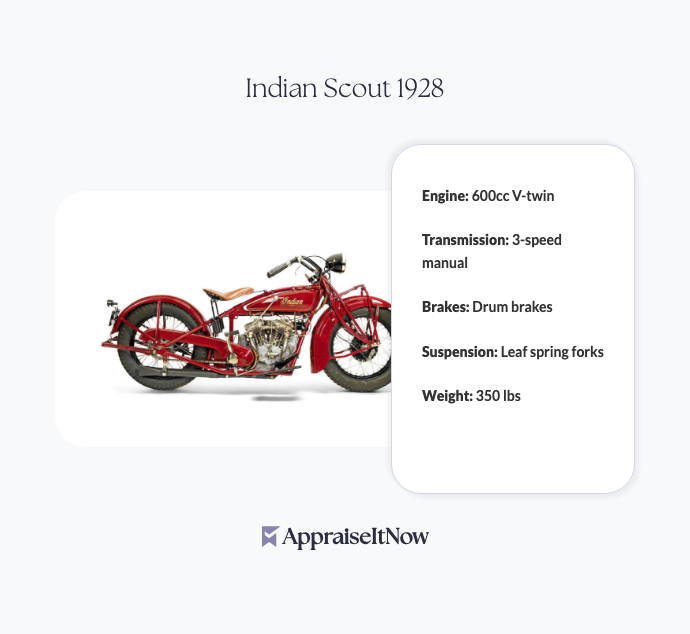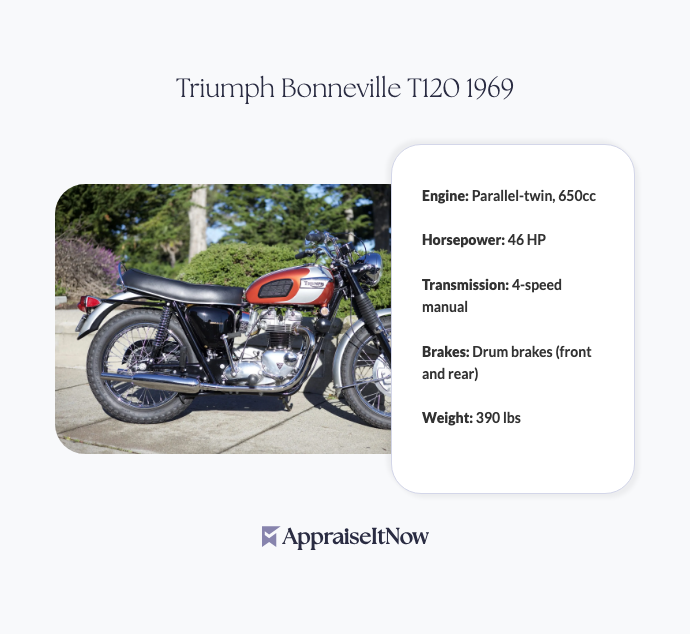<h1>How to Get Your Indian Scout 1928 Appraised</h1>
<p>The Indian Scout 1928 represents more than just a vintage motorcycle—it's a piece of American motorcycling history that commands serious collector attention. If you own one of these iconic machines or are considering acquiring one, understanding its current market value between <strong>$30,000 and $40,000</strong> requires professional expertise. Getting a certified appraisal ensures you have accurate documentation whether you're buying, selling, insuring, or planning your estate.</p>
<h2>Why the 1928 Indian Scout Matters to Collectors</h2>
<p>The Indian Scout holds a legendary status in motorcycle history. First introduced in 1920, the Scout evolved into the 1928 model you may own—a refined version featuring the legendary 600cc V-twin engine that became synonymous with American motorcycle engineering. Indian motorcycles were the backbone of early American motorcycling culture, and the Scout represents the brand at a pivotal moment when the company was establishing itself as a global manufacturer.</p>
<div class="callout tip"><p><strong>Market Insight</strong></p>
<p>The 1928 Scout sits at a sweet spot for collectors—early enough to possess genuine vintage character, yet relatively accessible compared to rarer pre-1920 Indian models or later collectible variants.</p></div>
<p>The 1928 model year specifically introduced several engineering refinements that make it particularly desirable. The frame construction improved dramatically over earlier versions, and the V-twin engine design delivered exceptional performance for the era. This combination of innovation and proven reliability explains why your Scout attracts serious bidders in today's <a href="/types/motorcycle">motorcycle</a> collector market.</p>
<h2>Understanding Your Indian Scout 1928's Value Drivers</h2>
<p>When appraisers evaluate a 1928 Indian Scout, they're examining multiple factors that collectively determine where your bike falls within the $30,000-$40,000 range—or potentially beyond for exceptional examples.</p>
<h3>Condition and Originality</h3>
<p>Your Scout's condition dramatically affects its appraisal value. Appraisers examine everything from the original paint and chrome finish to the integrity of the V-twin engine and frame. Original matching numbers across engine, frame, and transmission components significantly boost value. A Scout that retains its period-correct paint, seats, and hardware commands premiums of 15-25% over examples requiring restoration.</p>
<p>The distinction between preservation and restoration matters considerably. Many collectors prefer original patina with honest wear over perfect recreations, particularly for early models. However, mechanical functionality remains essential—a Scout that runs reliably outperforms non-operational examples regardless of cosmetic presentation.</p>
<h3>Documentation and Provenance</h3>
<p>Can you trace your Scout's ownership history? Documentation proving original ownership, service records, or period photographs dramatically increases appraisal value. Unlike some collectibles where provenance becomes nearly impossible to establish, motorcycle registrations and title histories are often discoverable through state archives or Indian enthusiast networks.</p>
<p>The Indian Motorcycle Company's legacy and the Scout's role in American culture create strong collector interest across multiple demographic groups. Whether your Scout has known racing history, belonged to a notable previous owner, or simply maintained consistent care, documentation of these facts strengthens your appraisal.</p>
<h3>Rarity Considerations</h3>
<p>Production figures matter for 1928 models. Indian manufactured approximately 20,000 motorcycles in 1928, with Scouts comprising a significant portion. While substantial production runs mean your Scout isn't extraordinarily rare in absolute terms, surviving original examples become progressively scarcer as decades pass. A 1928 Scout in excellent original condition represents genuine scarcity in today's market.</p>
<div class="callout note"><p><strong>Appraisal Factor</strong></p>
<p>Original parts from 1928 specifications command premium valuations. Reproduction components, while practical for riders, reduce collector appeal and appraisal values.</p></div>
<h2>How Your Scout Compares to Related Models</h2>
<p>Understanding how the 1928 Scout positions against related motorcycles helps contextualize its value. Many collectors wonder how much similar vintage motorcycles are worth—a 1928 Model A automobile, for comparison, typically values between $15,000 and $25,000, demonstrating that motorcycles of this era often command comparable or superior prices when in good condition.</p>
<p>The 1929 Indian Scout represents the final year of this generation before significant redesigns, sometimes commanding slightly higher values due to perceived scarcity. Conversely, the 1920 Indian Scout, while earlier and technically more historically significant, often values slightly lower due to increased wear on surviving examples. Your 1928 Scout occupies the ideal middle ground—mature enough for undeniable vintage character yet young enough that mechanical components remain more readily serviceable.</p>
<h2>Inflation and Historical Value Context</h2>
<p>You might wonder how much a dollar was worth in 1928 versus today. If your Scout originally sold for $300-$400 in 1928, that translates to approximately $5,000-$6,500 in today's dollars when accounting for inflation. Yet your Scout appraises at $30,000-$40,000—demonstrating that vintage motorcycle values have appreciated dramatically beyond simple inflation adjustments. This appreciation reflects growing collector demand, increasing scarcity, and recognition of the Scout's cultural significance in American motorcycling history.</p>
<h2>Investment Potential and Market Trends</h2>
<p>The Indian Scout 1928 has demonstrated strong appreciation over recent decades. Collectors increasingly recognize these motorcycles as tangible <a href="/types/personal-property">personal property</a> investments that provide both enjoyment and financial returns. Unlike cryptocurrency or more speculative assets, the Scout's value anchors to its mechanical functionality, historical importance, and universal appeal among motorcycle enthusiasts.</p>
<p>Do Indian motorcycles hold their value? The answer is decidedly yes for quality examples in good condition. Indian Scouts from the 1920s consistently appreciate or maintain value, particularly when compared to more speculative vintage purchases. This makes professional appraisals essential for insurance coverage—ensuring your motorcycle is insured for replacement value rather than undervalued based on outdated assessments.</p>
<p>When evaluating <a href="/blog/appraising-classic-and-vintage-motorcycles-determining-collectible-bike-worth">classic and vintage motorcycles</a>, appraisers assess both market comparables from recent sales and condition-based adjustments that reflect your specific machine's characteristics.</p>
<h2>Preparing Your Scout for Appraisal</h2>
<p>Getting an accurate appraisal begins with preparation. Gather any documentation you possess—original purchase records, maintenance logs, registration history, and photographs from various angles. For your 1928 Indian Scout, detailed photos of the engine, frame identification numbers, serial locations, and overall condition provide appraisers essential context before they conduct in-person evaluation.</p>
<p>Ensure your Scout is reasonably clean but not over-prepared. Appraisers value authenticity and can often detect recent cosmetic work. Present your motorcycle in its honest current state, allowing professionals to assess originality versus modifications or repairs.</p>
<div class="callout tip"><p><strong>Preparation Tip</strong></p>
<p>Document any recent work performed on your Scout, including parts replacements, mechanical repairs, or restoration efforts. This transparency helps appraisers understand condition and value trajectory.</p></div>
<h2>Why Professional Appraisal Matters</h2>
<p>The difference between casual estimation and certified appraisal becomes critical when your Scout's value approaches $30,000-$40,000. Insurance companies require documented appraisals for coverage above standard policies. Estate planning, asset division, or charitable donations all benefit from credentialed appraisals that withstand professional scrutiny.</p>
<p>AppraiseItNow connects you with specialists who understand the nuanced factors affecting vintage motorcycle values. Our certified appraisers possess expertise in <a href="/types/memorabilia-and-collectibles">memorabilia and collectibles</a>, offering USPAP-compliant documentation accepted by insurance carriers, financial institutions, and legal proceedings. Whether you're addressing an insurance claim, planning an estate, or verifying purchase price for a potential acquisition, professional appraisal provides defensible market analysis.</p>
<h2>The Role of Condition in Final Valuation</h2>
<p>Your 1928 Scout's final appraisal value hinges significantly on condition assessment. An original, well-maintained example in excellent mechanical condition easily commands $38,000-$40,000. A well-restored Scout with quality work and proper documentation might achieve $32,000-$36,000. An example requiring cosmetic or mechanical restoration could appraise in the $28,000-$32,000 range, even though the underlying motorcycle remains fundamentally sound.</p>
<p>Appraisers use detailed condition grading systems to objectively assess your Scout's state, creating transparent documentation of how condition factors translated into final valuation. This transparent process protects both buyers and sellers while ensuring insurance coverage accurately reflects replacement cost.</p>
<h2>Regional and Market Variations</h2>
<p>Scout values occasionally fluctuate by geographic location and regional collector demand. Areas with strong vintage motorcycle communities and established enthusiast networks often support consistent or premium pricing. Your Scout's local market conditions, combined with national comparable sales data, inform final appraisal figures.</p>
<p>The specialized nature of 1920s Indian motorcycles means appraisers must access national sales data and auction results to establish accurate comparables. This national perspective, combined with knowledge of your local market, produces balanced valuations that reflect realistic selling potential.</p>
<div class="callout note"><p><strong>Key Takeaway</strong></p>
<p>A certified appraisal of your Indian Scout 1928 provides essential documentation for insurance, sale, estate planning, or investment tracking purposes. Professional appraisers understand this motorcycle's historical significance, market demand, and condition-based valuation factors, ensuring your $30,000-$40,000 asset receives accurate, defensible documentation that protects your interests and reflects true market value.</p></div>







.avif)







